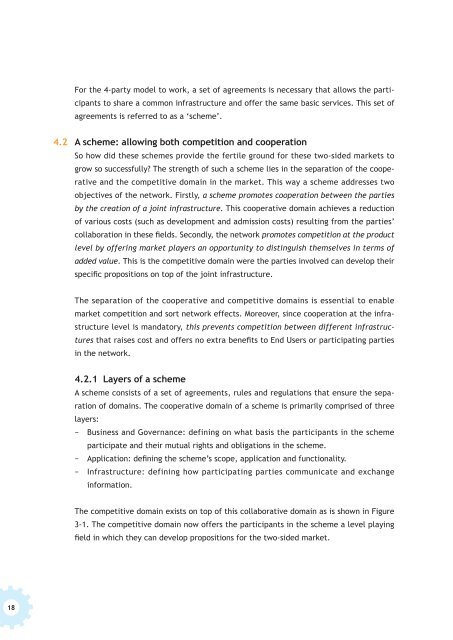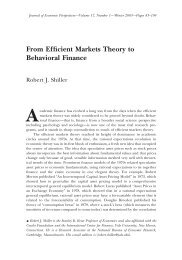A Network Approach to E-identification
A Network Approach to E-identification
A Network Approach to E-identification
- No tags were found...
You also want an ePaper? Increase the reach of your titles
YUMPU automatically turns print PDFs into web optimized ePapers that Google loves.
For the 4-party model <strong>to</strong> work, a set of agreements is necessary that allows the participants<br />
<strong>to</strong> share a common infrastructure and offer the same basic services. This set of<br />
agreements is referred <strong>to</strong> as a ‘scheme’.<br />
4.2 A scheme: allowing both competition and cooperation<br />
So how did these schemes provide the fertile ground for these two-sided markets <strong>to</strong><br />
grow so successfully The strength of such a scheme lies in the separation of the cooperative<br />
and the competitive domain in the market. This way a scheme addresses two<br />
objectives of the network. Firstly, a scheme promotes cooperation between the parties<br />
by the creation of a joint infrastructure. This cooperative domain achieves a reduction<br />
of various costs (such as development and admission costs) resulting from the parties’<br />
collaboration in these fields. Secondly, the network promotes competition at the product<br />
level by offering market players an opportunity <strong>to</strong> distinguish themselves in terms of<br />
added value. This is the competitive domain were the parties involved can develop their<br />
specific propositions on <strong>to</strong>p of the joint infrastructure.<br />
The separation of the cooperative and competitive domains is essential <strong>to</strong> enable<br />
market competition and sort network effects. Moreover, since cooperation at the infrastructure<br />
level is manda<strong>to</strong>ry, this prevents competition between different infrastructures<br />
that raises cost and offers no extra benefits <strong>to</strong> End Users or participating parties<br />
in the network.<br />
4.2.1 Layers of a scheme<br />
A scheme consists of a set of agreements, rules and regulations that ensure the separation<br />
of domains. The cooperative domain of a scheme is primarily comprised of three<br />
layers:<br />
− Business and Governance: defining on what basis the participants in the scheme<br />
participate and their mutual rights and obligations in the scheme.<br />
− Application: defining the scheme’s scope, application and functionality.<br />
− Infrastructure: defining how participating parties communicate and exchange<br />
information.<br />
The competitive domain exists on <strong>to</strong>p of this collaborative domain as is shown in Figure<br />
3-1. The competitive domain now offers the participants in the scheme a level playing<br />
field in which they can develop propositions for the two-sided market.<br />
18
















